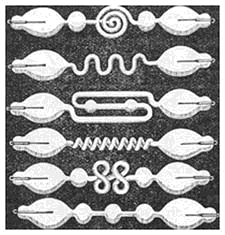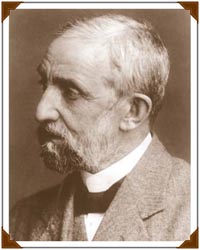
From an 1898 catalog
of demonstration
apparatus.

Typical cathode ray tube.
|
"There is no other branch of physics which affords
us so promising an opportunity of penetrating the secret of electricity." -- J.J. Thomson,
1893
 cience lecturers who traveled from town to town in the mid nineteenth century delighted audiences by showing them the ancestor of the neon sign. They took a glass tube with wires embedded in opposite ends... put a high voltage across... pumped out most of the air... and the interior of the tube would glow in lovely patterns. In 1859 a German physicist sucked out still more air with an improved pump and saw that where this light from the cathode reached the glass it produced a fluorescent glow. Evidently some kind of ray was emitted by the cathode and lighting up the glass. cience lecturers who traveled from town to town in the mid nineteenth century delighted audiences by showing them the ancestor of the neon sign. They took a glass tube with wires embedded in opposite ends... put a high voltage across... pumped out most of the air... and the interior of the tube would glow in lovely patterns. In 1859 a German physicist sucked out still more air with an improved pump and saw that where this light from the cathode reached the glass it produced a fluorescent glow. Evidently some kind of ray was emitted by the cathode and lighting up the glass.
 hat could these rays be? One possibility was that they were waves traveling in a hypothetical invisible fluid called the "ether." At that time, many physicists thought that this ether was needed to carry light waves through apparently empty space. Maybe cathode rays were similar to light waves? Another possibility was that cathode rays were some kind of material particle. Yet many physicists, including J.J. Thomson, thought that all material particles themselves might be some kind of structures built out of ether, so these views were not so far apart. hat could these rays be? One possibility was that they were waves traveling in a hypothetical invisible fluid called the "ether." At that time, many physicists thought that this ether was needed to carry light waves through apparently empty space. Maybe cathode rays were similar to light waves? Another possibility was that cathode rays were some kind of material particle. Yet many physicists, including J.J. Thomson, thought that all material particles themselves might be some kind of structures built out of ether, so these views were not so far apart.
|
"The most diverse opinions
are held as to these rays... It would seem at first sight that
it ought not to be difficult to discriminate between views so different, yet experience
shows that this is not the
case..." -- J.J. Thomson, "Cathode Rays" (1897). |
|
 xperiments
were needed to resolve the uncertainties. When physicists moved
a magnet near the glass, they found they could push the rays about. But
when the German physicist Heinrich Hertz passed the rays through an electric
field created by metal plates inside a cathode ray tube, the rays were
not deflected in the way that would be expected of electrically charged
particles. Hertz and his student Philipp Lenard also placed a thin metal
foil in the path of the rays and saw that the glass still glowed, as though
the rays slipped through the foil. Didn't that prove that cathode rays
were some kind of waves? xperiments
were needed to resolve the uncertainties. When physicists moved
a magnet near the glass, they found they could push the rays about. But
when the German physicist Heinrich Hertz passed the rays through an electric
field created by metal plates inside a cathode ray tube, the rays were
not deflected in the way that would be expected of electrically charged
particles. Hertz and his student Philipp Lenard also placed a thin metal
foil in the path of the rays and saw that the glass still glowed, as though
the rays slipped through the foil. Didn't that prove that cathode rays
were some kind of waves?
|

Philipp Lenard
|
 ther experiments cast doubt on the idea that these were ordinary particles of matter, for example gas molecules as some suggested. In France, Jean Perrin had found that cathode rays carried a negative charge. In Germany, in January 1897 Emil Wiechert made a puzzling measurement indicating that the ratio
of their mass to their charge was over a thousand times smaller than the ratio for the smallest charged atom. When Lenard passed cathode rays through a metal foil and measured how far they traveled through various gases, he concluded that if these were particles, they had to be very small. ther experiments cast doubt on the idea that these were ordinary particles of matter, for example gas molecules as some suggested. In France, Jean Perrin had found that cathode rays carried a negative charge. In Germany, in January 1897 Emil Wiechert made a puzzling measurement indicating that the ratio
of their mass to their charge was over a thousand times smaller than the ratio for the smallest charged atom. When Lenard passed cathode rays through a metal foil and measured how far they traveled through various gases, he concluded that if these were particles, they had to be very small.
|
 |
 rawing
on work by his colleagues, J.J.
Thomson refined some previous experiments, designed some new ones,
carefully gathered data, and then... made a bold speculative leap. Cathode
rays are not only material particles, he suggested, but in fact the building
blocks of the atom: they are the long-sought basic unit of all matter
in the universe. rawing
on work by his colleagues, J.J.
Thomson refined some previous experiments, designed some new ones,
carefully gathered data, and then... made a bold speculative leap. Cathode
rays are not only material particles, he suggested, but in fact the building
blocks of the atom: they are the long-sought basic unit of all matter
in the universe.
|
|
Table of Contents:
Exhibit Home
J.J. Thomson
Mysterious Rays 
1897 Experiments
Corpuscles to Electrons
Legacy for Today
More Info |
 The 1897 Experiments The 1897 Experiments
|



